Aman Verma
CPEP: Contrastive Pose-EMG Pre-training Enhances Gesture Generalization on EMG Signals
Sep 04, 2025Abstract:Hand gesture classification using high-quality structured data such as videos, images, and hand skeletons is a well-explored problem in computer vision. Leveraging low-power, cost-effective biosignals, e.g. surface electromyography (sEMG), allows for continuous gesture prediction on wearables. In this paper, we demonstrate that learning representations from weak-modality data that are aligned with those from structured, high-quality data can improve representation quality and enables zero-shot classification. Specifically, we propose a Contrastive Pose-EMG Pre-training (CPEP) framework to align EMG and pose representations, where we learn an EMG encoder that produces high-quality and pose-informative representations. We assess the gesture classification performance of our model through linear probing and zero-shot setups. Our model outperforms emg2pose benchmark models by up to 21% on in-distribution gesture classification and 72% on unseen (out-of-distribution) gesture classification.
Modeling electronic health record data using a knowledge-graph-embedded topic model
Jun 03, 2022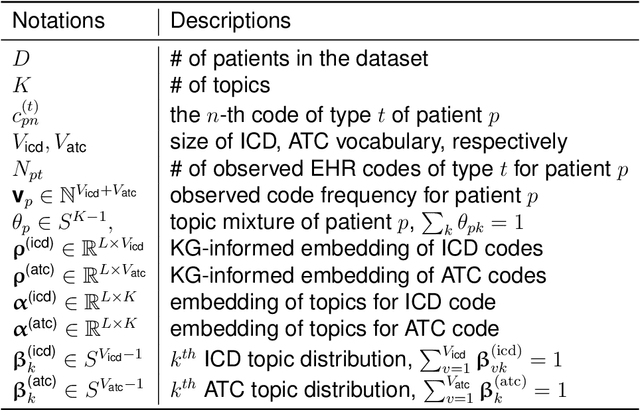
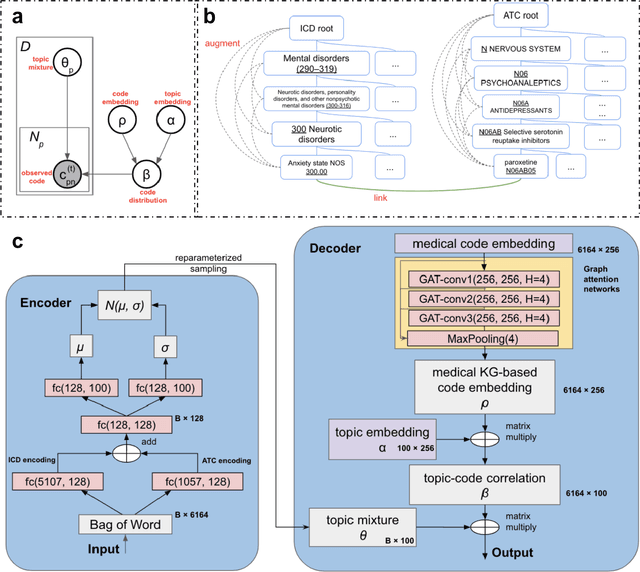


Abstract:The rapid growth of electronic health record (EHR) datasets opens up promising opportunities to understand human diseases in a systematic way. However, effective extraction of clinical knowledge from the EHR data has been hindered by its sparsity and noisy information. We present KG-ETM, an end-to-end knowledge graph-based multimodal embedded topic model. KG-ETM distills latent disease topics from EHR data by learning the embedding from the medical knowledge graphs. We applied KG-ETM to a large-scale EHR dataset consisting of over 1 million patients. We evaluated its performance based on EHR reconstruction and drug imputation. KG-ETM demonstrated superior performance over the alternative methods on both tasks. Moreover, our model learned clinically meaningful graph-informed embedding of the EHR codes. In additional, our model is also able to discover interpretable and accurate patient representations for patient stratification and drug recommendations.
HSADML: Hyper-Sphere Angular Deep Metric based Learning for Brain Tumor Classification
Jan 28, 2022



Abstract:Brain Tumors are abnormal mass of clustered cells penetrating regions of brain. Their timely identification and classification help doctors to provide appropriate treatment. However, Classifi-cation of Brain Tumors is quite intricate because of high-intra class similarity and low-inter class variability. Due to morphological similarity amongst various MRI-Slices of different classes the challenge deepens more. This all leads to hampering generalizability of classification models. To this end, this paper proposes HSADML, a novel framework which enables deep metric learning (DML) using SphereFace Loss. SphereFace loss embeds the features into a hyperspheric-manifold and then imposes margin on the embeddings to enhance differentiability between the classes. With utilization of SphereFace loss based deep metric learning it is ensured that samples from class clustered together while the different ones are pushed apart. Results reflects the promi-nence in the approach, the proposed framework achieved state-of-the-art 98.69% validation accu-racy using k-NN (k=1) and this is significantly higher than normal SoftMax Loss training which though obtains 98.47% validation accuracy but that too with limited inter-class separability and intra-class closeness. Experimental analysis done over various classifiers and loss function set-tings suggests potential in the approach.
Design, Manufacturing, and Controls of a Prismatic Quadruped Robot: PRISMA
Dec 27, 2021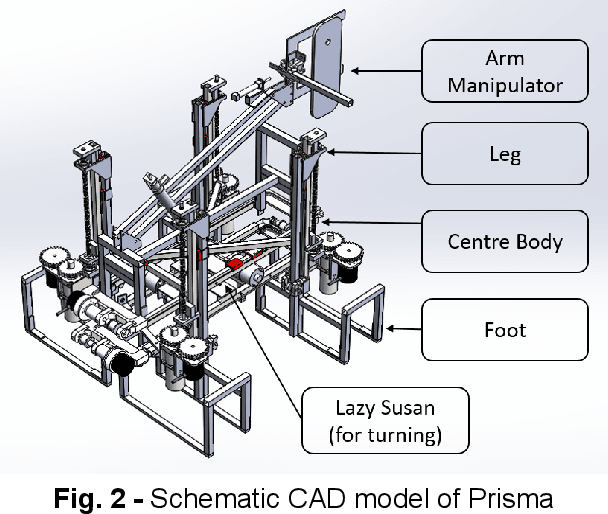
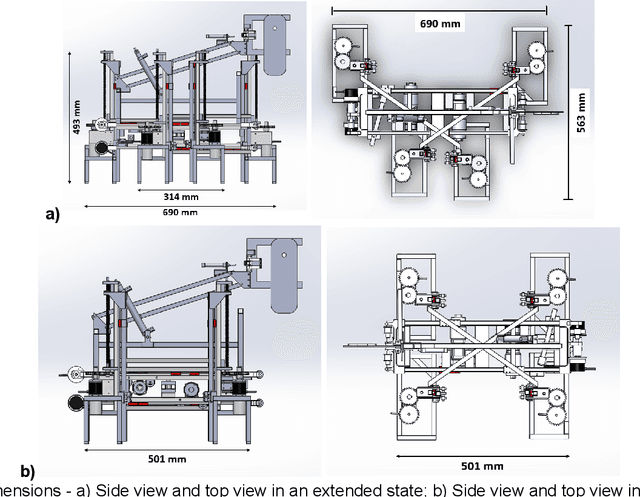
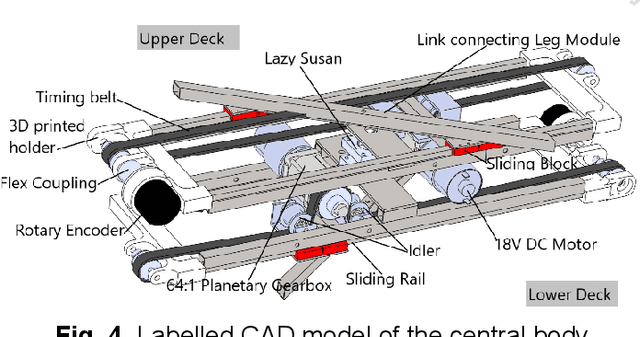

Abstract:Most of the quadrupeds developed are highly actuated, and their control is hence quite cumbersome. They need advanced electronics equipment to solve convoluted inverse kinematic equations continuously. In addition, they demand special and costly sensors to autonomously navigate through the environment as traditional distance sensors usually fail because of the continuous perturbation due to the motion of the robot. Another challenge is maintaining the continuous dynamic stability of the robot while walking, which requires complicated and state-of-the-art control algorithms. This paper presents a thorough description of the hardware design and control architecture of our in-house prismatic joint quadruped robot called the PRISMA. We aim to forge a robust and kinematically stable quadruped robot that can use elementary control algorithms and utilize conventional sensors to navigate an unknown environment. We discuss the benefits and limitations of the robot in terms of its motion, different foot trajectories, manufacturability, and controls.
DFCANet: Dense Feature Calibration-Attention Guided Network for Cross Domain Iris Presentation Attack Detection
Nov 01, 2021



Abstract:An iris presentation attack detection (IPAD) is essential for securing personal identity is widely used iris recognition systems. However, the existing IPAD algorithms do not generalize well to unseen and cross-domain scenarios because of capture in unconstrained environments and high visual correlation amongst bonafide and attack samples. These similarities in intricate textural and morphological patterns of iris ocular images contribute further to performance degradation. To alleviate these shortcomings, this paper proposes DFCANet: Dense Feature Calibration and Attention Guided Network which calibrates the locally spread iris patterns with the globally located ones. Uplifting advantages from feature calibration convolution and residual learning, DFCANet generates domain-specific iris feature representations. Since some channels in the calibrated feature maps contain more prominent information, we capitalize discriminative feature learning across the channels through the channel attention mechanism. In order to intensify the challenge for our proposed model, we make DFCANet operate over nonsegmented and non-normalized ocular iris images. Extensive experimentation conducted over challenging cross-domain and intra-domain scenarios highlights consistent outperforming results. Compared to state-of-the-art methods, DFCANet achieves significant gains in performance for the benchmark IIITD CLI, IIIT CSD and NDCLD13 databases respectively. Further, a novel incremental learning-based methodology has been introduced so as to overcome disentangled iris-data characteristics and data scarcity. This paper also pursues the challenging scenario that considers soft-lens under the attack category with evaluation performed under various cross-domain protocols. The code will be made publicly available.
Supervised multi-specialist topic model with applications on large-scale electronic health record data
May 04, 2021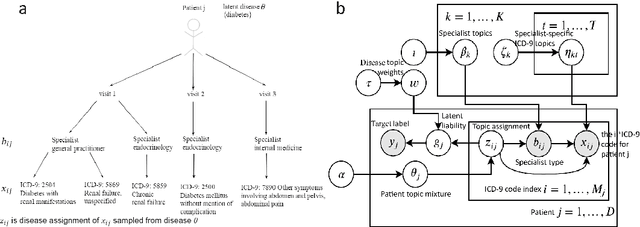
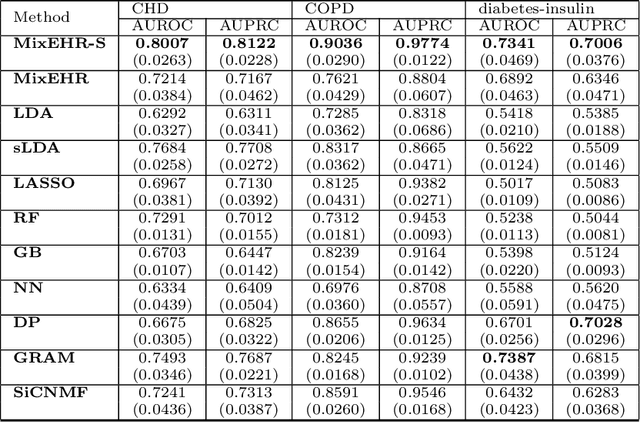
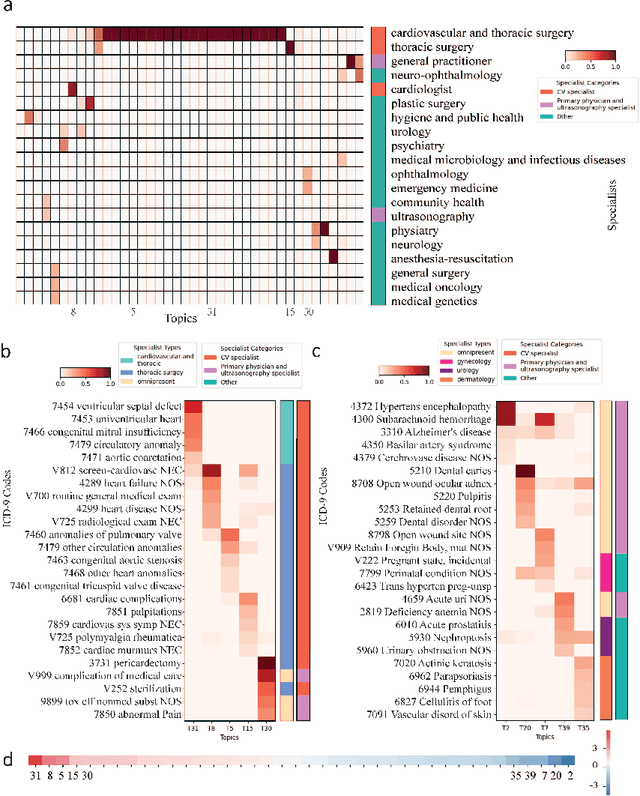
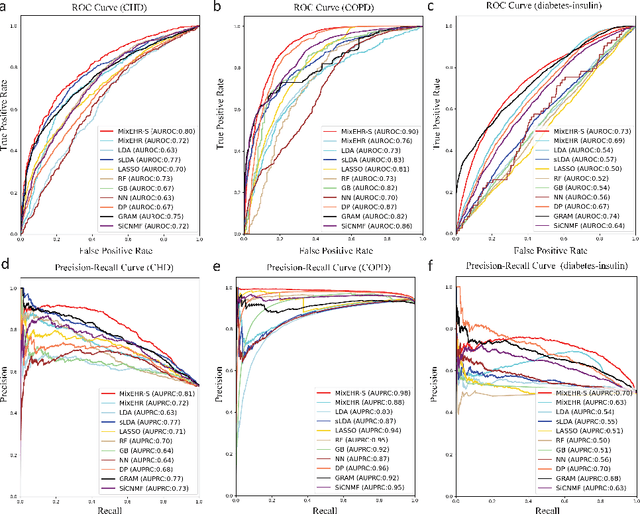
Abstract:Motivation: Electronic health record (EHR) data provides a new venue to elucidate disease comorbidities and latent phenotypes for precision medicine. To fully exploit its potential, a realistic data generative process of the EHR data needs to be modelled. We present MixEHR-S to jointly infer specialist-disease topics from the EHR data. As the key contribution, we model the specialist assignments and ICD-coded diagnoses as the latent topics based on patient's underlying disease topic mixture in a novel unified supervised hierarchical Bayesian topic model. For efficient inference, we developed a closed-form collapsed variational inference algorithm to learn the model distributions of MixEHR-S. We applied MixEHR-S to two independent large-scale EHR databases in Quebec with three targeted applications: (1) Congenital Heart Disease (CHD) diagnostic prediction among 154,775 patients; (2) Chronic obstructive pulmonary disease (COPD) diagnostic prediction among 73,791 patients; (3) future insulin treatment prediction among 78,712 patients diagnosed with diabetes as a mean to assess the disease exacerbation. In all three applications, MixEHR-S conferred clinically meaningful latent topics among the most predictive latent topics and achieved superior target prediction accuracy compared to the existing methods, providing opportunities for prioritizing high-risk patients for healthcare services. MixEHR-S source code and scripts of the experiments are freely available at https://github.com/li-lab-mcgill/mixehrS
Modeling disease progression in longitudinal EHR data using continuous-time hidden Markov models
Dec 03, 2018


Abstract:Modeling disease progression in healthcare administrative databases is complicated by the fact that patients are observed only at irregular intervals when they seek healthcare services. In a longitudinal cohort of 76,888 patients with chronic obstructive pulmonary disease (COPD), we used a continuous-time hidden Markov model with a generalized linear model to model healthcare utilization events. We found that the fitted model provides interpretable results suitable for summarization and hypothesis generation.
 Add to Chrome
Add to Chrome Add to Firefox
Add to Firefox Add to Edge
Add to Edge